North Carolina is known as the Old North State and stands in the southeastern part of the United States. The state consists of a mountainous region, a central Piedmont region, and an Atlantic coastal plain region. In these regions, you can find a total of 17 river basins, a haven for both flora and fauna of this place.
Regarding animal life, North Carolina is home to opossums, armadillos, rodents, lagomorphs (rabbits), eulipotyphlans (moles and shrews), bats, a wide range of carnivorans, even-toed ungulates, birds, reptiles and others.
Naturally, the list is much longer when it comes to flora, with over 30 orders (which, in turn, include many species) of plants present in the state. In the following lines, you’ll find out more about some of the native plants found in North Carolina.

What Is a Native Plant?
Native plants are local plants. As per the definition, native plants are recognized as the species of flora that have been naturally growing in a region for thousands of years (or more). Another term often used to describe native plants is indigenous.
Regarding characteristics, native implies immaculate adaptation to the region’s ecosystem, soil conditions, light, and climate.
10 Native Plants in North Carolina
1. Loblolly Pine
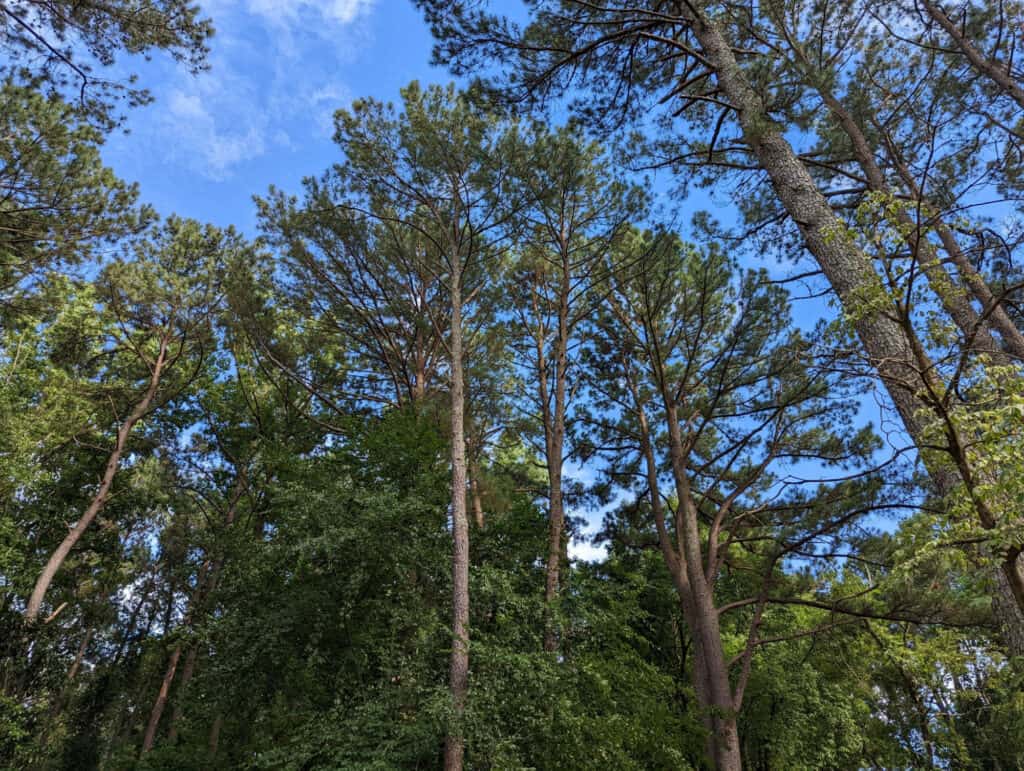
The loblolly pine is the second-most common tree species in the United States.
©Sierra Tango/Shutterstock.com
| Loblolly Pine | |
|---|---|
| Scientific name | Pinus taeda |
| Type of plant | Perennial |
| Distribution | Southeastern United States |
The loblolly pine is native to the southeastern part of the United States, mostly throughout the region’s coastal states. According to the Forest Service, it is the second-most common tree species in the country. The first on the list is the red maple.
Loblolly pine specimens usually grow up to 98-115 feet (30-35 m) tall and are characterized by a long trunk and a rather small crown. It features needles gathered in groups of three and as long as 4.75 – 8.75 inches (12-22 cm). The species has evergreen characteristics, as its needles can stay attached for up to two years.
2. Shumard Oak

The Shumard oak is also known as the swamp red oak, Schneck oak, and spotted oak.
©iStock.com/JOSE LUIS VEGA GARCIA
| Shumard Oak | |
|---|---|
| Scientific name | Quercus shumardii |
| Type of plant | Perennial |
| Distribution | Atlantic coastal plain, various southeastern states |
The Shumard oak is also known as the swamp red oak, Schneck oak, and spotted oak, to name a few. It is part of the red oak group of species and is, in fact, one of its largest representatives. Quercus shumardii can grow up to 82-115 feet (25-35 m) tall and has a trunk diameter of about 24-39 inches (12-18 m). Mature specimens also exhibit a large crown of up to 59 feet (18 m) wide.
What can help you distinguish Shumard oaks are its autumnal leaves, which turn crimson red. During the rest of the year, they are dark green on top and have lighter green shades on the bottom. Quercus shumardii is often used for decorative purposes and, as such, is found shading sidewalks.
3. Buttonbush
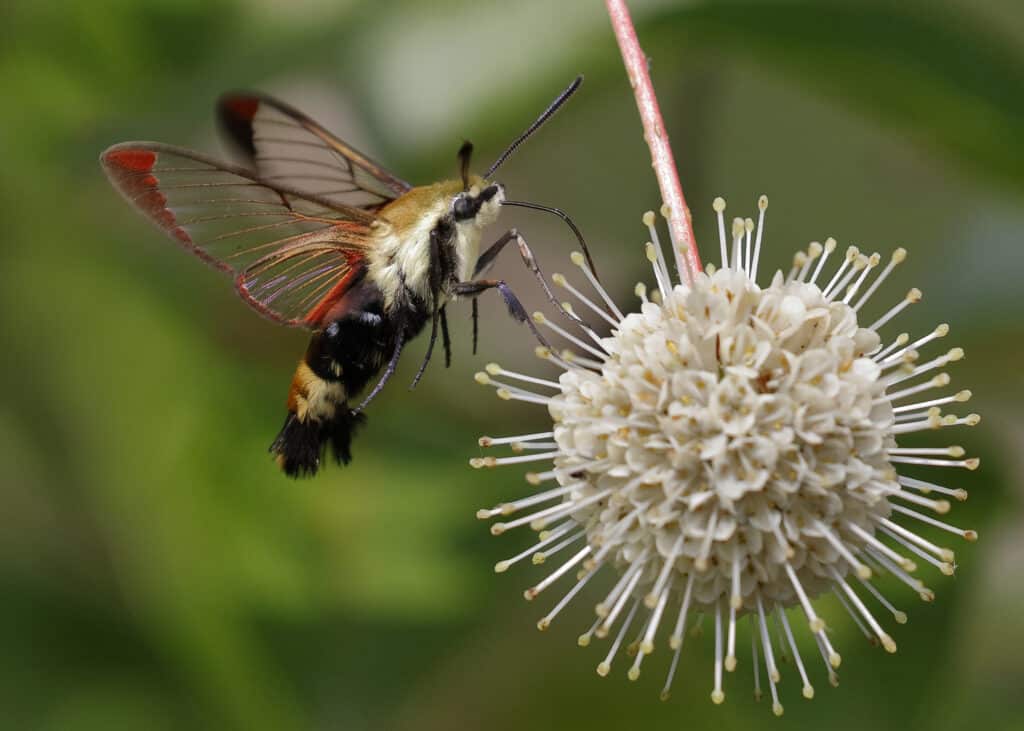
The buttonbush is part of the
Rubiaceaefamily.
©iStock.com/BrianLasenby
| Buttonbush | |
|---|---|
| Scientific name | Cephalanthus occidentalis |
| Type of plant | Deciduous |
| Distribution | Eastern and Southern North America |
The buttonbush is part of the Rubiaceae family, also known as the bedstraw, madder, or coffee family (it includes lianas, shrubs, trees, and herbs that feature opposite leaves and sympetalous actinomorphic flowers). Cephalanthus occidentalis is also called buck brush, honey-bells, and button-willow.
The shrub can grow up to 3.3-9.8 feet (1-3 m) tall. When it’s not too tall, it is referred to as a shrub, but when it grows close to its maximum height, it’s considered a small tree. It can rarely get as tall as 20 feet (6 m). It is characterized by its unique blooming flowers – spherical inflorescences sitting on short peduncles.
4. Inkberry

The inkberry plant can be found throughout the United States East Coast, where it grows in colonies.
©Yingna Cai/Shutterstock.com
| Inkberry | |
|---|---|
| Scientific name | Ilex glabra |
| Type of plant | Evergreen |
| Distribution | Eastern North America, coastal plain |
Many names, such as gallberry, evergreen winterberry, dye-leaves, and Appalachian tea, know the inkberry. It is, as its family suggests (Aquifoliaceae), a species of holly. The plant can be found throughout the United States East Coast, where it grows in colonies.
The inkberry can reach heights of up to 5-8 feet (1.4-2.4 m) tall and doesn’t have many noteworthy characteristics, especially during the growing period. It features compacta leaves that are flat, spineless, glossy, and dark green. They usually retain their glossy green aspect during winter. If bearing fruit, the inkberry will present jet black drupes. They are the size of a pea and resemble berries.
5. Catawba Rhododendron

The Catawba rhododendron is a shrub that can grow up to 9.8 feet tall.
©iStock.com/Wirestock
| Catawba Rhododendron | |
|---|---|
| Scientific name | Rhododendron catawbiense |
| Type of plant | Evergreen |
| Distribution | Eastern United States |
With a mouthful of a name, we present the Catawba rhododendron, a species that you could also refer to as red laurel, rosebay laurel, mountain rosebay, purple ivy, or Catawba rosebay. It has a limited natural range in the eastern United States – namely in the southern part of the Appalachian Mountains, from Virginia to northern Alabama.
The Catawba rhododendron is a shrub that can grow up to 9.8 feet (3 m) tall but can be seen exhibiting heights of up to 16.4 feet (5 m) as well. It can be identified by its violet-purple flowers that often feature small streaks or spots of color. You’ve probably seen it already, as it is a popular ornamental plant throughout North America.
6. Sundrops
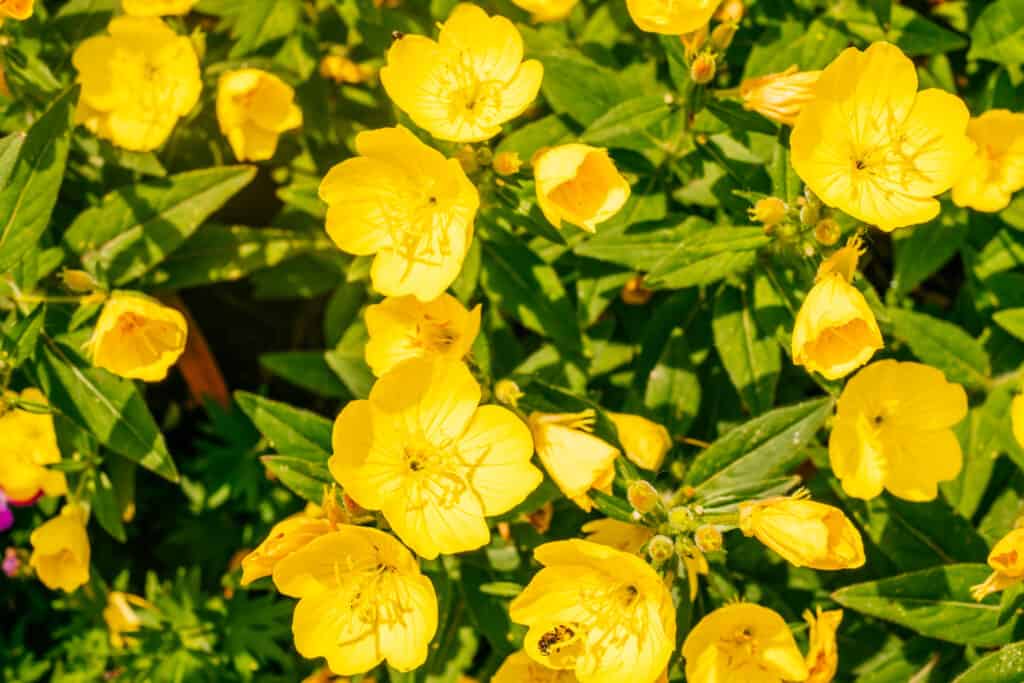
The sundrops plant can be found throughout eastern North America in almost all habitats.
©iStock.com/Christina Vartanova
| Sundrops | |
|---|---|
| Scientific name | Oenothera fruticosa |
| Type of plant | Perennial |
| Distribution | Eastern North America |
Also known as the narrow-leaved sundrops or narrowleaf evening primrose, sundrops is part of the Onagraceae family (often referred to as the evening primrose or willowherb family). The plant can be found throughout eastern North America in almost all habitats, ranging from moist savannas to dry woodlands.
As the name implies, sundrops looks like drops of the sun – thanks to its bright yellow-greenish flowers. The flowers have the shape of a saucer or a cup and usually appear in late spring. These sit on top of a stem measuring roughly 8-35 inches (20-90 cm) tall (depending on climate and growing conditions).
7. Mountain Mint

The mountain mint is part of the mint family (Lamiaceae).
©I, SB Johnny / CC BY-SA 3.0, via Wikimedia Commons – License
| Mountain Mint | |
|---|---|
| Scientific name | Pycnanthemum tenuifolium |
| Type of plant | Perennial |
| Distribution | Central and eastern North America |
Also called the Virginia thyme, common horsemint, narrowleaf mountain mint, and slender mountain mint, this plant is part of the mint family (Lamiaceae). Its scientific name, Pycnanthemum tenuifolium, means, in translation from Greek and Latin, dense flower with thin leaves.
Naturally, the scientific name gives the plant justice – it features 2-inch-long (5 cm) leaves that are only 0.25 inches (0.60 cm) wide. They are shaded by flowers growing in half-round flower heads. Even though the plant bears the mint name, the specific fragrance isn’t as strong as in other species.
8. Calico Aster
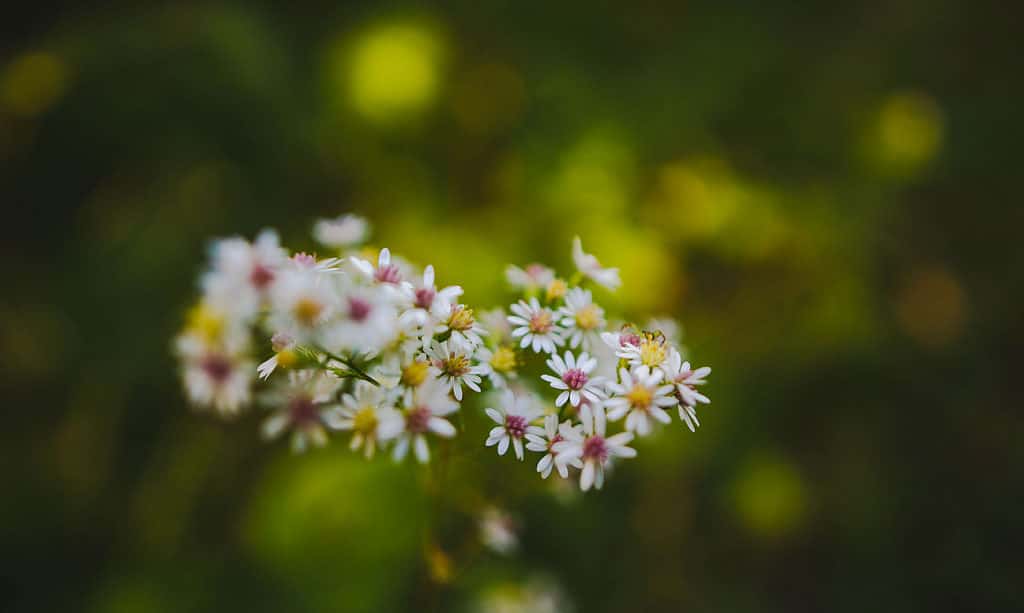
The calico aster can grow up to 4 feet tall.
©iStock.com/Wirestock
| Calico Aster | |
|---|---|
| Scientific name | Symphyotrichum lateriflorum (formerly Aster lateriflorus) |
| Type of plant | Perennial |
| Distribution | Eastern and central North America |
Known as the calico aster, white woodland aster, and starved aster, this plant is part of the Asteraceae family of asters, daisies, and sunflowers. This specific species, Symphyotrichum lateriflorum is a section of a subgenus of the Symphyotrichum genus (part of a subtribe in the Asterae tribe). In short, it has a complex classification, and studying it is quite difficult!
The calico aster can grow up to 4 feet (120 cm) tall and is characterized by predominantly white flowers with loose ray florets surrounding a complex center. The flowers consist of 7 to 15 ray florets that are usually white but can be found purple- or pink-tinted and of disk florets that can be pink, brown, or purple.
9. Northern Maidenhair
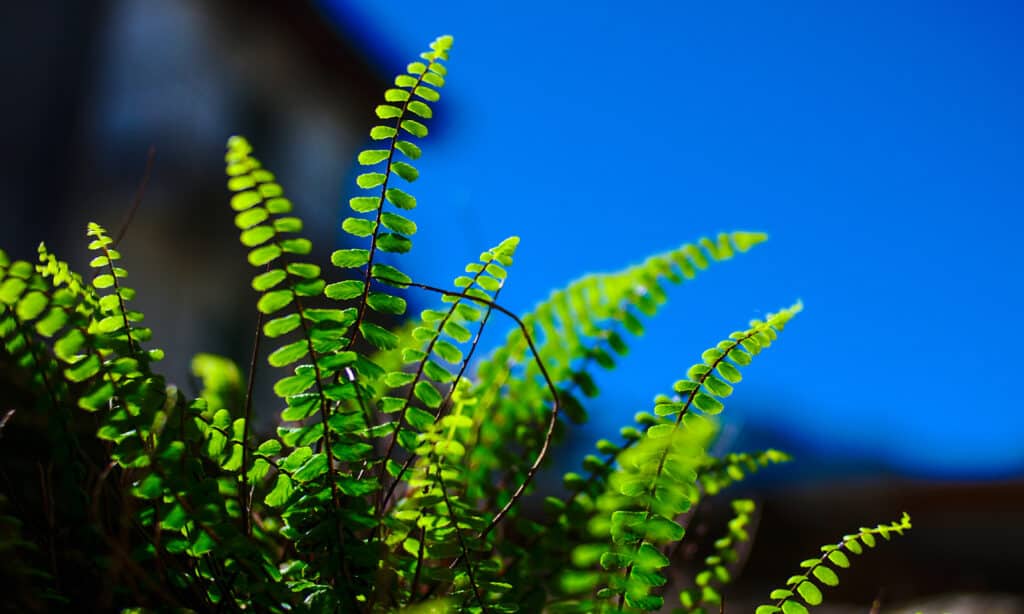
The northern maidenhair fern can attain heights of up to 12-30 inches.
©Willi Burkhardt/Shutterstock.com
| Northern Maidenhair | |
|---|---|
| Scientific name | Adiantum pedatum |
| Type of plant | Deciduous |
| Distribution | Eastern North America, East Asia, the Himalayas |
Known as the five-fingered or northern maidenhair fern, this plant can be found in eastern North America, especially in moist forests – and very close to the ground. It can attain heights of up to 12-30 inches (30-75 cm), but it looks like it’s sitting right on the surface of the ground from above.
Its name comes from the fact that it features shining black stipes, like many other fern species that are part of the Adiantum genus. A stipe is a stalk that has a support role for other structures or elements. In the case of the northern maidenhair, the stipes are slender and barely noticeable from above.
10. Christmas Fern

Fronds of the Christmas fern can grow up to 12-31 inches long and can be as broad as 2-4.7 inches.
©Young Swee Ming/Shutterstock.com
| Christmas Fern | |
|---|---|
| Scientific name | Polystichum acrostichoides |
| Type of plant | Perennial |
| Distribution | Eastern North America |
The Christmas fern is one of the most common ferns found throughout its native range, namely in eastern North America. You can come across this species if you find yourself on rocky slopes, stream banks, or woodlands – or any other shady and moist habitats. As you’ve probably guessed, the species is called Christmas fern because it keeps its fronds throughout most of the winter or at least up until Christmas.
Fronds can grow up to 12-31 inches (30-80 cm) long and can be as broad as 2-4.7 inches (5-12 cm). They sport a dark green color and leathery texture. Because of this, they are visible from afar in broad daylight.
Summary of the 10 Native Plants in North Carolina
Explore this list of native plants you will find in North Carolina:
| Rank | Native Plants in North Carolina |
|---|---|
| 1. | Loblolly Pine |
| 2. | Shumard Oak |
| 3. | Buttonbush |
| 4. | Inkberry |
| 5. | Catawba Rhododendron |
| 6. | Sundrops |
| 7. | Mountain Mint |
| 8. | Calico Aster |
| 9. | Northern Maidenhair |
| 10. | Christmas Fern |
Up Next:
- 10 Amazing Mountains in North Carolina
- Appalachian Trail in North Carolina: 10 Facts You Didn’t Know
- Discover 12 Incredible Places to See Fall Foliage in North Carolina
The photo featured at the top of this post is © iStock.com/Christina Vartanova
Sources
- Our State Magazine, Available here: https://www.ourstate.com/native-plants-in-north-carolina/
- N.C. Cooperative Extension, Available here: https://content.ces.ncsu.edu/extension-gardener-handbook/12-native-plants
- Plantly, Available here: https://plantly.io/plant-care/north-carolina-native-plants/
- North Carolina Wildlife Federation, Available here: https://ncwf.org/habitat/native-pollinator-plants/perennial-annual-flowers/
Thank you for reading! Have some feedback for us? Contact the AZ Animals editorial team.






